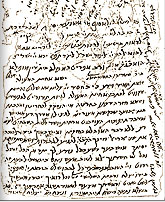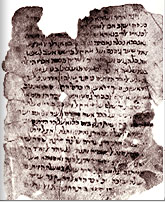|
courtesy of Yad Ben Zvi
courtesy of Yad Ben Zvi
|
|

The Literature

courtesy of Yad Ben Zvi |
Not much of the literature produced by the Yeshiva of Eretz Israel has survived. Nonetheless, the texts that have survived shed light on the nature of the religious teachings of the Jews in Israel during the Ge'onic period (634-1099) and testify to the important role of the Yeshiva in the life of the Jewish People. The literary works of the Yeshiva comprise most of the Rabbinic literature genres: midrash, halakha (Jewish law), piyyutim (liturgical poems), apocalyptic literature, Hebrew grammar, masora and cantillation marks, and responsa. |
A main feature of the works of the Eretz Israel Yeshiva is their use of midrashic interpretations of biblical passages for rendering halakhic decisions. This type of works is characteristic of the Ashkenazi sages and has no parallel in the halakhic rulings of Babylonia or Muslin Spain during that period. The latter were influenced by the Muslim preoccupation with philology, which brought about the development of Biblical exegesis based on the plain text (peshat), emphasizing its philological aspects. Eretz Israel, which was far from the center of Muslim culture in Baghdad and a provincial territory, was not affected by this development. Three of the other literary genres – apocalyptic works, aggada and piyyutim – declined greatly during the eighth century and practically ceased. These works, which are characterized by expressions of messianic hopes, blossomed during the sixth-seventh centuries CE when there was hope for redemption from the Byzantine rule. This hope died out with the Muslim conquest and with it died the literary creativity.
The halakhic literature, of which fewer texts have survived, reflects the same decline in literary production from the seventh-eighth to the ninth-tenth centuries. During the first part of the period (sixth-seventh centuries) the editing of the Minor Tractates of the Talmud was completed in Palestine. Some of the sources there preserve laws and customs that are characteristic of the Jewish culture in Eretz Israel at that time. The most important surviving halakhic work of this period is Sefer Ha-Ma'asim Li-Venei Eretz Israel (The Book of Rulings of the People of the Land of Israel). This book contains halakhic decisions based on court rulings of cases that had actually been brought before a magistrate. It is therefore an invaluable source for studying the halakhic tradition of the Jews of Eretz Israel during the end of the Byzantine and beginning of the Islamic period. Other halakhic books written in Palestine are Terefot de-Eretz Israel (Laws of Ritually Unfit Animals), Sefer Berakhot u-Shetarot (Book of Benedictions and Deeds), Pinkas Halakha (Halakhic Notebook) and Hilkhot 'Arayot shel Benei Israel (Laws of Prohibited Marriages).
The responsa literature was the main connection between the Jews of Eretz Israel and the Diaspora since the Second Temple period. This form of literature consists of responses to halakhic questions addressed to the sages of Israel. Only few of the responsa of the Geonic period had survived, appearing sporadically in different sources. This makes it almost impossible to study the halakhic developments of that period as well as the connections between the Jewish community in Palestine and the Diaspora. |
|
Most of the surviving halakhic works date from the beginning of the Geonic period, thus indicating that the Yeshiva of Eretz Israel had served as a center for Torah studies during those days. Responsa literature, on the other hand, was poorly produced by the geonim of Eretz Israel, probably since the inquirers preferred to turn to the Babylonian sages, who were greatly renowned among the Jews of the Diaspora. |

|


